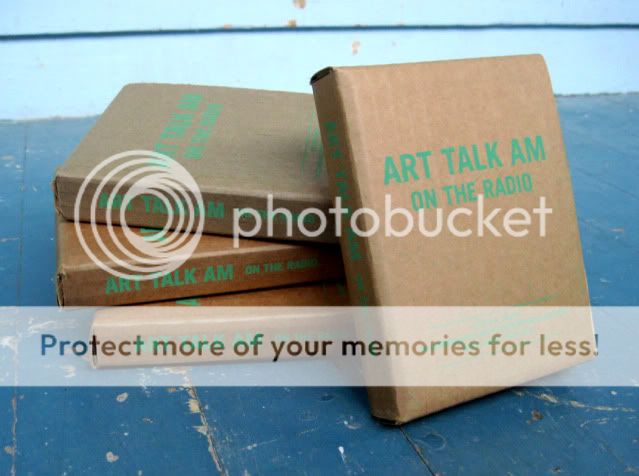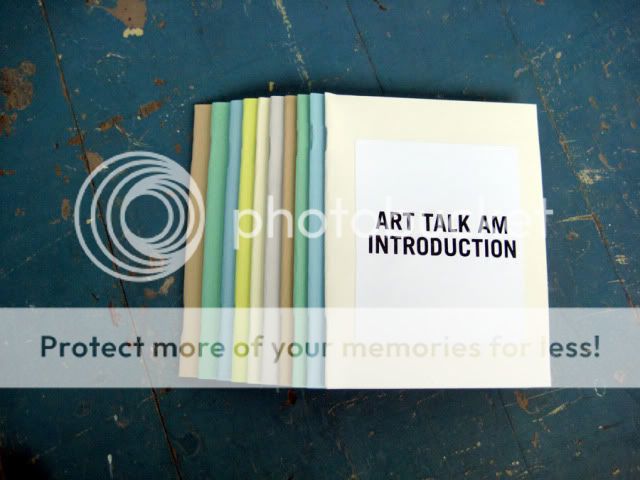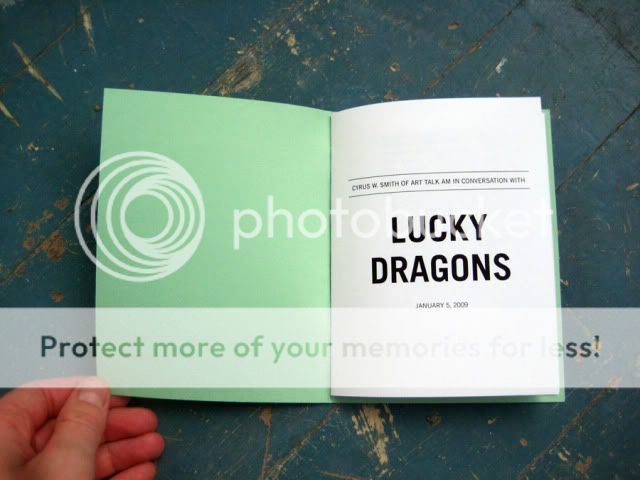It can be a daunting task to design and execute a book that will catch the eye of bookstore browsers; that task can be even more difficult for independent and self-publishing artists who are often on a limited budget. I rarely go into shops like New York’s Printed Matter, Los Angeles’ Family, or Chicago’s now-defunct Golden Age with any particular titles in mind. Instead, I meander around and allow the covers, book sizes, and print quality to guide me from shelf to shelf in search of books I’ve never heard of or seen before. I was doing just this a few years ago when I stumbled upon a cardboard slip-jacket with sea-foam green screenprinted lettering that read “Art Talk AM on the Radio,” and just below that, “Cyrus W. Smith in conversation with contemporary artists KPSU Radio 2008-2009.” Aside from what little information the cover provided me, I had no idea what this book was about. Inside the jacket, there were ten saddle-stitch (stapled) booklets with muted pastel covers. Instead of opening the contents to preview them, I went ahead and purchased the last copy without hesitation.

Art Talk AM on the Radio, 2009. Image courtesy of Nicole Lavelle.
“Available nowhere on the AM dial, and now scheduled on the afternoons, ‘Art Talk AM on the Radio’ relies on its mellow mood and conversational tone to live up to the ‘AM’ title. Guests to the show are invited to engage in a one hour conversation about their work, as well as provide a few audio tracks to share with the audience.” – Cyrus W. Smith
From 2008-2009, Art Talk AM on the Radio was a weekly radio show hosted by Cyrus W. Smith, a graduate student in Portland State University’s Art and Social Practice program, and broadcast on KPSU radio in conjunction with the MFA Monday Night Lecture Series. Interviewed the day of each artist’s lecture, the artists’ conversations with Smith served to document and archive the diverse lecture series, which has included Hamza Walker, Mark Dion, and Larry Sultan, among others.

Art Talk AM on the Radio, 2009. Image courtesy of Nicole Lavelle.
While living in Oregon this past year, I attended several PSU lectures and was surprised by the community turnout. Questions and comments were not only asked by the program’s students, but by members of the entire audience, creating a vibrant community dialogue. Unlike many visiting artist series, the artists were easy to access for interviews during the period leading up to the talks. I took advantage of this and was able to have a conversation with Laylah Ali for my website, Black Visual Archive, and was even invited to a private talk with her and the program’s graduate students after the lecture. It is this open dialogue and transparency that defines the Art and Social Practice program, which welcomed Smith’s radio show with open arms.
The nine transcribed interviews contained within this collection were conducted with Regine Basha, Harrell Fletcher & Jen Delos Reyes, Dan Attoe, Patrick Rock, Courtney Fink, Chris Johanson, Calvin Johnson, Lucky Dragons and Daniel Bozhkov. There is also an introductory booklet that explains Smith’s interview process and his decision for selecting these particular guests for the book. When discussing his interviewees, Smith writes, “I treated each guest as the expert on their own life and work; myself taking the role of the inquisitive student and researcher.” This process allows for a casualness that engages the listener or reader, and appeals to an audience beyond the art community.

Art Talk AM on the Radio, 2009. Image courtesy of Nicole Lavelle.
Designed by Oregon-based Nicole Lavelle, the collection strikes a balance between being well-designed while still displaying the laborer’s hand–I would even go so far as to call it “DIY Chic.” The booklets alone are much smaller than your standard zine and appear to be hand-stapled, so that the staples create a staggered line when all of the booklets are lined up–like the Black Flag logo, but longer. Although I generally do not gravitate towards handmade books, I find Art Talk AM to be overwhelmingly endearing. So what if the stickers on each of the ten covers are slightly crooked, and the pages don’t lay perfectly? The black and white photocopies of artworks contained in each booklet are not trying to be anything other than what they are–photocopies. For all of the construction quirks, the rich content and overall package/aesthetic make up for the books’ flaws.

Art Talk AM on the Radio, 2009. Image courtesy of Nicole Lavelle.
Overall, the colors are rather muted and make use of the limited color palette that standard 65 lb cover paper offers–Crackling Canary, Smoke Grey, Popper-Mint Green, and Bottle-Rocket Blue (yes, these really are the names given to different colors of paper). The slipcase, which looks to be constructed from recycled cardboard, not only holds all of the interviews together but is the design’s highlight. The book manages to look inexpensive and precious at the same time, while its weight compares to that of vintage books on tape–too large to fit in your pocket, yet small enough to carry.
Many people have explored practices through the documentation of recordings, most notably William Furlong’s recently-published Speaking of Art: Four Decades of Art in Conversation and Phaidon’s massive compendium pressPLAY: Contemporary Artists in Conversation. Translating an audio conversation into a physical object can be difficult, due to the added tactile experience and the subtracted listening experience, which, through certain aesthetic choices, Smith has executed mindfully. Art Talk AM on the Radio brings a certain charm and preciousness to the documentation of conversations, creating an intimate experience that expands upon the interviews themselves.




